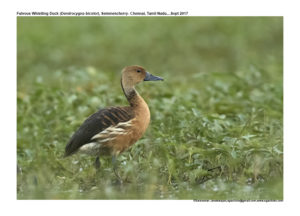Fulvous Whistling Duck |

Fulvous Whistling Duck Dendrocygna bicolor
Etymology :
- Dendrocygna : Derndron – Tree ; Cygnus – Swan in Greek { Tree Swan}
- Bicolor : Latin word bi– two; color- colour {Two Colours}
Distribution in India: Resident of North East India.
Description: Size of 50-51 cm. It is a long-legged duck, mainly golden-brown with a darker back and an obvious blackish line down the back of its neck. It has whitish stripes on its flanks, a long grey bill and grey legs. In flight, the wings are brown above and black below, with no white markings, and a white crescent on the rump contrasts with the black tail. All plumages are fairly similar, but the female is slightly smaller and duller-plumaged than the male.
Habitat : It is found in various types of marshy habitats and swamps in open, flat terrain, including both freshwater and brackish wetlands. Generally associated with good development of tall-grass vegetation. Particularly frequent in rice fields.
Food Habits: It feeds in wetlands by day or night, often in mixed flocks with relatives such as white-faced or black-bellied whistling ducks. Its food is generally plant material, including seeds, bulbs, grasses and stems, but females may include animal items such as aquatic worms, molluscs and insects as they prepare for egg-laying, which may then comprise up to 4% of their diet. Ducklings may also eat a few insects. Foraging is by picking plant items while walking or swimming, by upending, or occasionally by diving to a depth of up to 1 m.
Breeding Habits: They breed in Jun-Oct. They exhibit lifelong monogamy. The courtship display is limited to some mutual head-dipping before mating and a short dance after copulation in which the birds raise their body’s side-by-side while treading water. Pairs may breed alone or in loose groups. Nest is made from plant leaves and stems and has little or no soft lining. It is usually built in dense vegetation and close to water but sometimes in tree holes. In India, the use of tree holes, and even the old nests of raptors or crows, is much more common than elsewhere. Eggs are laid at roughly 24- to 36-hour intervals, starting before the nest is complete, resulting in some losses from the clutch. The clutch is of ten eggs, but other females sometimes lay into the nest, so 20 or more may be found on occasion. Eggs may also be added to the nests of other species, like Ruddy Duck. Both sexes incubate, changing over once a day, with the male often taking the greater share of this duty. The eggs hatch in about 24–29 days. They are precocial and leave the nest after a day or so, but the parents protect them until they fledge around nine weeks later. Eggs and duckling may be preyed on by mammals, birds and reptiles, although one parent may try to distract a potential predator with a broken-wing display while the other adult leads the ducklings away.